#piecing is contemporary too
Text




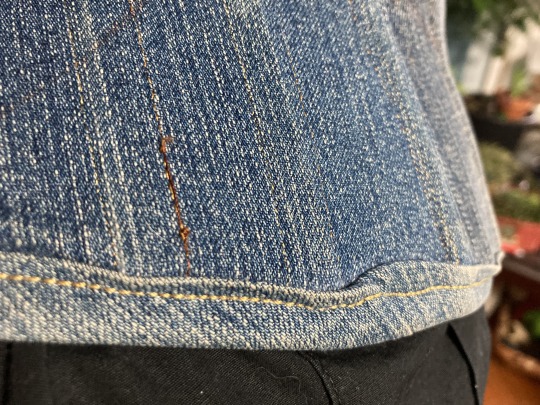


made this corset many years ago as 1) a back brace bc my spine was high key dysfunctional 2) a wearable mockup for the flocked black denim corset i was planning. i dont have either corset anymore and i dont believe i have any pictures of the black one (shame it had a beautiful peacock brocade lining). both were designed to be flat chested corsets in whats normally called the overbust style. though here there is no bust to be gone over
this denim one is made to close at 24" --corsets, especially steel corsets like this, are usually designed to be worn with a gap at the back but for back support i wanted the steel right up against my spine--and is laced in the back with paracord*. at the time i made it, i could zip it closed in front without loosening the back at all. this corset wasn't designed to constrict or really even to shape at all, just to prop up my bones. i wore it every day for a couple years and it was the most comfortable thing i owned at the time
the main pictures here (the in focus ones) were taken more recently, just before i gave it away. obviously it no longer closes (this is a success story) but it still fits well. i could have tried closing it but my ribs dont appreciate constriction so i just documented it as is. i have included 2 old and blurry pictures at the end for an idea of how it fit at the time it was made. i still miss those purple jeans
*paracord is a not a great lacing material but i wasnt adjusting this guy ever. i did pull the core out at least which made it both flatter and more maneuverable. it has a lot of tooth (friction) so it doesnt slide well but it does work as a cheap lacing material if you dont mind haulin on it
#sewing#denim corset#corset#cotton#disability accommodations#physical#historical fashion#lacing#new build#pattern adjustment#piecing is contemporary too#steel#structured garment#wearable mockup#zipper#can you believe i couldn't walk or stand or sit upright without a metal brace for years and didn't even think i was disabled#thats growth dot gif
14 notes
·
View notes
Note
Opinion on Josh Groban in the great comet of 1812??
I like his performance in it quite a bit — I enjoy him as a singer pretty much always however sometimes he takes me a bit out of things during dialogue segments just because he speaks in such a dramatic way, but it fits the source very well in the case of great comet. also his hair was really good in it he should do that with his hair again
#sanswers#I don’t have too many opinions about great comet in general though. it’s very much just a show that I casually enjoy#great show to see. great cautionary tale about the dangers of building your audience on stuntcasting. you know the deal#my favorite aspect is def the music (which josh is wonderful at singing) I wish more period pieces would actually compose in the style of#(looking at YOU great gatsby)#ok I am gonna stop before this turns into a rant about the pasek and paulification of contemporary musical theatre
5 notes
·
View notes
Text
I love doing Pride events so much. For this smaller parade there were only a few of us from the local costume clubs and 3 of us were doing Owl House costumes (me, an Eda, and a Willow) and halfway through the parade a teen in a Bad Girl Coven t-shirt started hollering at us, and then as we were leaving an older trans woman saw me with my flower crown and grinned so widely and tripped over her words a little saying “I’m trans! You’re trans like me!”
Just the absolute most delightful combination of people being excited about us showing up in cosplay and people being excited about being queer. I want to live at the intersection of that Venn diagram always.
#doing owl house cosplay for a pride event is so FUN too because the show really is a piece of contemporary queer culture#which is how you get people wearing shirts from the show as pride gear#like i love being in a cosplay group that does pride events in general but. having half of us doing toh costumes just felt right#and a LOT of people recognized us and got really excited#i hope i can get raine done by twin cities pride though!!#today there was a funny moment where someone from the sisters of perpetual indulgence came over to bless us all with glitter#except between my mask and long sleeves and gloves i had no exposed skin#so everybody else got glittered normally but they looked at me contemplatively for a bit before smearing it on my flag pole haha#i love............. queer people and being queer
52 notes
·
View notes
Text
Trying to find fiction media/books to consume while chanting "SHADY SCIENTIFIC FACILITIES, SHADY SCIENTIFIC FACILITIES"
#sighhh#sci fi tropes#sci fi#i know i asked before but this is more of a general trope post than an attempt to find recs post#if you know any i'm all ears or well partially ears#don't you dare name a stephen king or dean koontz book to me#or a YA or childrens book like i want the protagonists to at least be in their 20s#is that too much to ask apparently#uhhhh anyway yeah#why can there be no shady scientific facilities in relatively contemporary setting come on my man#it can't possibly be that rare a trope#yet i find it impossible to find anything fitting my criteria#like contemporary semi believable sci-fi i mean it should be a piece of cake#like the government literally had experiments going on irl in the 70s for mind control and junk just bend it a little to be more sci-fi#and bada bing bada boom you don't need this a hundred years in the future this happened decades in the past#give me my adult/new adult shady scientific experiment facilities bplease
51 notes
·
View notes
Text
youtube
THE DREAMER THAT REMAINS: A STUDY IN LOVING, by Harry Partch
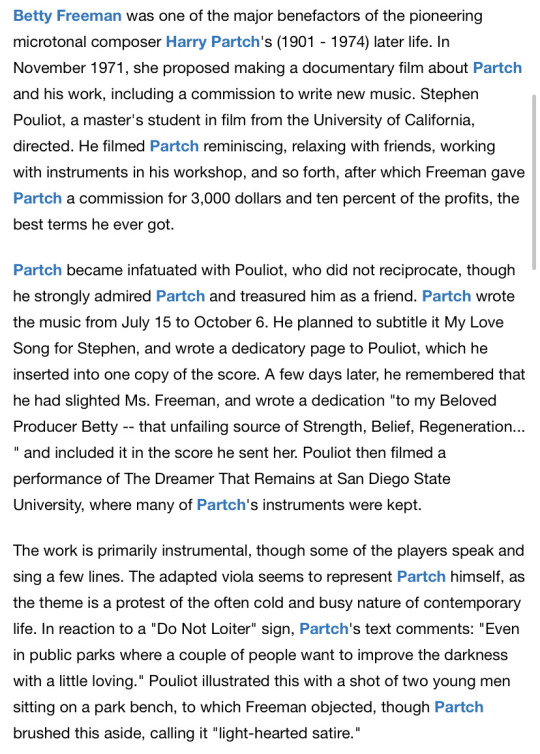

#Harry Partch#contemporary classical#happy pride#you gotta let the beautiful raw hurt too#(listen to the piece without the film first imo to be honest—-it also stands alone)
3 notes
·
View notes
Text

“Melt your Mind”
Date: 11.13.2020
Made this for my sculpture class a couple of years ago. I’m weirdly proud of this one.
Made entirely out of candles (approximately 30 or more were used).
Detail shots of this piece are under the cut

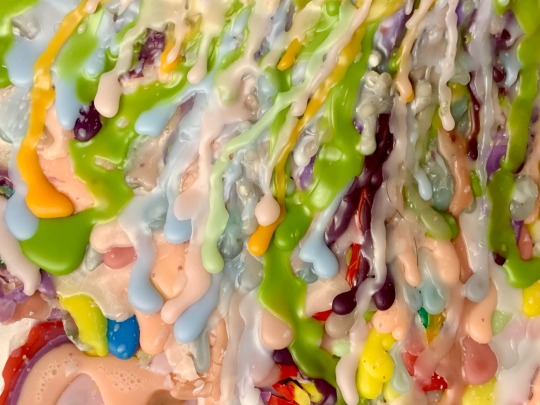


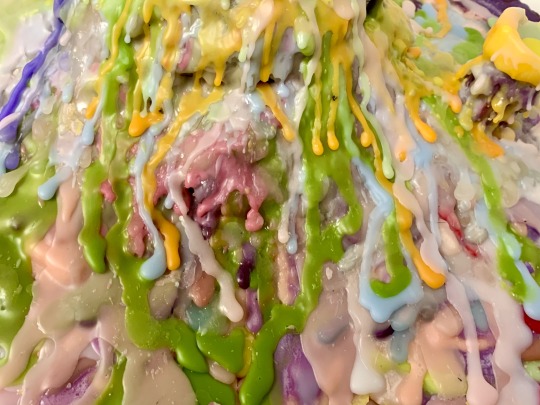

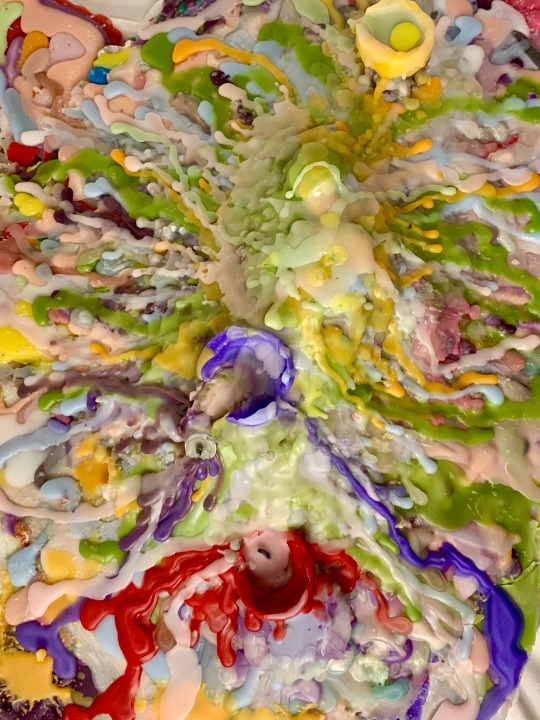
#sculpture#contemporary sculpture#contemporary art#artist of tumblr#abstract sculpture#candle art#3d art#having to light these was a bitch bc i couldnt leave it alone and if i had multiple scented candles going it would be stanky#but not the bad kind of stinky it was just very overwhelming#also i am now responsible for the candle shortage in my parent’s place#i made this during quarantine too wahoo#i dont post a lot of my art on this account but i think this piece is fitting for the vibe
11 notes
·
View notes
Text
i have to submit fallout 4 footage to one of my actual professors by tomorrow
#the project is about the use of classical music in contemporary media#meaning for example. the classical radio station in fallout 4#there's a camille saint-saëns movement on that radio station called the swan. part of carvival of the animals#that i'm like 99% certain was included because of edgar swann. swan lake is there too but that's too basic#i am required to submit a video example of my chosen song being used in my chosen piece of media#and since it's highly unlikely that someone else has recorded this specific movement of this specific song playing in fallout 4#the duty falls to me. i've been playing fallout 4 with the fucking CLASSICAL RADIO on constantly#absolutely surreal#fallout#shitpost#fallout 4#fo4
14 notes
·
View notes
Text
Currently having the most nightmarish sheet music acquiring experience. Thank god for IMSLP and filetype:pdf ❤️
#discovered much too late that all of the purchase links my professor sent me the other day are for physical copies#with 6-8 week overseas shipping……. and my competition is. tomorrow#signed up for a free trial to a sheet music subscription#only to discover I couldn’t download the files 😭#and THEN I discovered I couldn’t even screenshot/screen record them. screaming#luckily I found a PDF after about an hour of frenzied Googling#my other pieces are either in a book or public domain but. yikes this was exhausting#oh well. tomorrow will be fun ^_^ had a great day today too despite all the stress haha#ellyposting#musicposting#tl;dr… LOVE contemporary music. HATE contemporary pricing and gatekeeping and blah blah blah I hate it
1 note
·
View note
Text
loce reblogging and seeing contemporary art on tumblr, the one thing i hate about it is that . they just don't post the context
#people forget that most contemporary art relies on the context from the artist or their background to be appreciated#without context youre missing out kn a lot of the piece's and the artists philosophy#come on huys its not just looking pretty can you guys post the context too#candy's monologue
0 notes
Text
poetry outlets that support a free palestine
after finding out that the poetry foundation/POETRY magazine pulled a piece that discussed anti-zionism because they "don't want to pick a side" during the current genocide, i decided to put together a list of online outlets who are explicitly in solidarity with palestine where you can read (english-language) poetry, including, except where otherwise stated, by palestinian poets!
my criteria for this is not simply that they have published palestinian poets or pro-palestine statements in the past; i only chose outlets that, since october 7, 2023, have done one of the following:
published a solidarity statement against israeli occupation & genocide
signed onto the open letter for writers against the war on gaza and/or the open letter boycotting the poetry foundation
published content that is explicitly pro-palestine or anti-zionist, including poetry that explicitly deals with israeli occupation & genocide
shared posts that are pro-palestine on their social media accounts
fyi this is undoubtedly a very small sample. also some of these sites primarily feature nonfiction or short stories, but they do all publish poetry.
outlets that focus entirely on palestinian or SWANA (southwest asia and north africa) literature
we are not numbers, a palestinian youth-led project to write about palestinian lives
arab lit, a magazine for arabic literature in translation that is run by a crowd-funded collective
sumuo, an arab magazine, platform, and community (they appear to have a forthcoming palestine special print issue edited by leena aboutaleb and zaina alsous)
mizna, a platform for contemporary SWANA (southwest asian & north africa) lit, film, and art
the markaz review, a literary arts publication and cultural institution that curates content and programs on the greater middle east and communities in diaspora
online magazines who have published special issues of all palestinian writers (and all of them publish palestinian poets in their regular issues too)
fiyah literary magazine in december 2021, edited by nadia shammas and summer farah (if you have $6 usd to spare, proceeds from the e-book go to medical aid for palestinians)
strange horizons in march 2021, edited by rasha abdulhadi
the baffler in june 2021, curated by poet/translators fady joudah & lena khalaf tuffaha
the markaz review has two palestine-specific issues, on gaza and on palestinians in israel, currently free to download
literary hub featured palestinian poets in 2018 for the anniversary of the 1948 nakba
adi magazine, who have shifted their current (october 2023) issue to be all palestinian writers
outlets that generally seem to be pro-palestine/publish pro-palestine pieces and palestinian poetry
protean magazine (here's their solidarity statement)
poetry online (offering no-fee submissions to palestinian writers)
sundog lit (offering no-fee submissions to palestinian writers through december 1, 2023)
guernica magazine (here's a twitter thread of palestinian poetry they've published) guernica ended up publishing a zionist piece so fuck them too
split this rock (here's their solidarity statement)
the margins by the asian-american writers' workshop
the offing magazine
rusted radishes
voicemail poems
jewish currents
the drift magazine
asymptote
the poetry project
ctrl + v journal
the funambulist magazine
n+1 magazine (signed onto the open letter and they have many pro-palestine articles, but i'm not sure if they have published palestinian poets specifically)
hammer & hope (signed onto the letter but they are a new magazine only on their second issue and don't appear to have published any palestinian poets yet)
if you know others, please add them on!
4K notes
·
View notes
Text
most writing advice is good as long as you know why it is good, at which point it is also bad. the hardest thing (and most precious thing) about being an artist is that you gotta learn how to take critique. i don't mean "just shut up and accept that people hate your work," i mean you need to learn what the critique is saying and then figure out if it actually helps.
i usually tell people reading my work: "i'm collecting data, so everything is useful." i ask them where they put the book down, even though it's too long for most people to read in 1 sitting. i ask them what they thought of certain characters. i let them tell me it was really good but i like it more when they look a little stunned and say i forgot i was reading your book, which means they forgot i exist, which is very good news.
sometimes people i didn't ask will read my work and tell me i don't like it. and that is okay, you don't have to like it. but i look at the thing that they don't like and try to figure out if i care. i don't like that you don't capitalize. this one is common, and i have already thought about it. i do not care, it's because of chronic pain and frankly i like the little shape of small letters. you use teeth and ribs in all your work. actually that is very true. i don't know what's up with that. next time i will work to figure out a different word, thank you. you're whiny, go outside. someone said that to me recently and it made me laugh. i am on the whine-about-it website as an internet poet. you are in my native habitat, watching me perform a natural enrichment behavior. but i like the dip of whiny, how the word itself does "whine" (up/down, the sound out your nose on the y), but i don't know if i want to feel whiny. maybe next time i will work on it being melancholy, like what you would call a male writer's poetry.
repeated "good" advice clangs in a bell and doesn't hold a real shape, dilutes in the water. like sometimes you will hear "don't use said." you turn that around in your head and it bounces off the edges of your brain like it is a dvd screensaver. it isn't bad advice, but it feels wrong somehow, like saying easy choices are illegal! sometimes i will only use "said." sometimes i will just kick dialogue tags out to the trash. sometimes i make little love poems where the fact that i do not say "said" is very bad, and makes you feel bad in your body, because someone didn't say something. i am a contrary little shitbird, i guess.
but it is also good advice, actually. it is trying to say that "said" sometimes is clutter. it makes new writers think about the very-small words and very-small choices, because actually your work matters and wordchoice matters. "i know," you said. "i know," you sighed. "i know." we both know but neither of us use a dialogue tag, because we are in a contemporary lit piece.
it is too-small to say don't use said. but it is a big command, so it gets your attention. what are you relying on? what easy choices do you make? when you edit, do you choose the same thing? can you make a different choice? sometimes we need the blankness of said, how it slides into the background. sometimes we don't.
i usually say best advice is to read, but i also mean read books you don't like, because that will make you angry enough to write your own book. i also mean read good books, which will break your heart and remind you that you are a very small person and your voice is a seashell. i also mean you need to eat books because reading a book is a writer's version of studying.
my creative writing teacher in the 7th grade had a big red list of no! words and on it was SUNSET. RAZORS. LOVE. GALAXY. DEATH. BLOOD. PAIN. I liked that razor and love were tucked next to each other like birds, and found it funny that he believed we were too young to know the weight of razor in the context of pain. i hated him and his Grateful Dead belt, where the colored teddy bears held up his appraisal of us. i hated his no list. it is very good/bad advice. i wasn't old enough yet to know that when you are writing about death you are also writing about sunsets and when you write about love you are tucking yourself into a napkin that never stops folding.
back then my poetry was all bloody, dripped with agony when you picked it up. i didn't know there is nothing beautiful about a razor, nothing exciting about pain. i just understood sharpness, which he took to mean i understood nothing. i wrote the razor down and it wasn't easy, but it was necessary. that's what i'm saying - sometimes it's good advice, because it's not always necessary. and sometimes it is very bad advice, because writing about it is lifesaving.
hang on my dog was just having a nightmare. i heard that it is a rule not to write about dogs - in my creative writing mfa, my teacher rolled her eyes and said everyone writes a dead dog. the literature streets are littered in canine bodies. i watched the rise and fall of his ribs (there is that word again) and had to reach out and stop the bad dream. when he woke up he didn't recognize me, and he was afraid.
it is good/bad advice to say that poems and writing have to mean something. it is bad/good advice to say they're big feelings in small packages. it is better advice to say that when my dog saw where he was, he relaxed immediately, rubbed his face against me. someone on instagram would make fun of that moment by writing their "internet poetry" as a sentence that tumbles across a white page:
outside it is sunset and
my dog is still in a gutter, bleeding a galaxy
out of his left paw.
or maybe it would be: i woke the dog up/the dog forgot i loved him/and i saw the shape of a senseless/and impossible pain.
the dog is alive in this one, and he is happy. when i tell you i love you, i know what i said. write what you need to write, be gentle to yourself about it. the advice is only as good as far as it helps. the rest is just fencing. take stock of the boundaries, and then break them. there's always somewhere else you could be growing.
i love you, keep going.
2K notes
·
View notes
Text
Look if there's one thing, just one thing, that I wish everyone understood about archiving, it's this:
We can always decide later that we don't need something we archived.
Like, if we archive a website that's full of THE WORST STUFF, like it turns out it's borderline illegal bot-made spam art, we can delete it. Gone.
We can also chose not to curate. You can make a list of the 100 Best Fanfic and just quietly not link to or mention the 20,000 RPFs of bigoted youtubers eating each other. No problem!
We can also make things not publicly available. This happens surprisingly often: like, sometimes there'll be a YouTube channel of alt-right bigotry that gets taken down by YouTube, but someone gives a copy to the internet archive, and they don't make it publicly available. Because it might be useful for researchers, and eventually historians, it's kept. But putting it online for everyone to see? That's just be propaganda for their bigotry. So it's hidden, for now. You can ask to see it, but you need a reason.
And we can say all these things, we can chose to delete it later, we can not curate it, we can hide it from public view... But we only have these options BECAUSE we archived it.
If we didn't archive it, we have no options. It is gone. I'm focusing on the negative here, but think about the positive side:
What if it turns out something we thought was junk turns out to be amazing new art?
What if something we thought of as pointless and not worth curating turns out to be influential?
What if something turns out to be of vital historical importance, the key that is used to solve a great mystery, the Rosetta stone for an era?
All of those things are great... If we archived it when we could.
Because this is an asymmetric problem:
If we archived it and it turns out it's not useful, we can delete.
If we didn't archive it and it turns out it is useful, OOPS!
You can't unlose something that's been lost. It's gone. This is a one way trip, it's already fallen off the cliff. Your only hope is that you're wrong about it being lost, and there is actually still a copy somewhere. If it's truly lost, your only option is to build a time machine.
And this has happened! There are things lost, so many of them that we know of, and many more we don't know of. There are BOOKS OF THE BIBLE referenced in the canon that simply do not exist anymore. Like, Paul says to go read his letter to the Laodiceans, and what did that letter say? We don't know. It's gone.
The most celebrated playwright in the English tradition has plays that are just gone. You want to perform or watch Love's Labours Won? TOO FUCKING BAD.
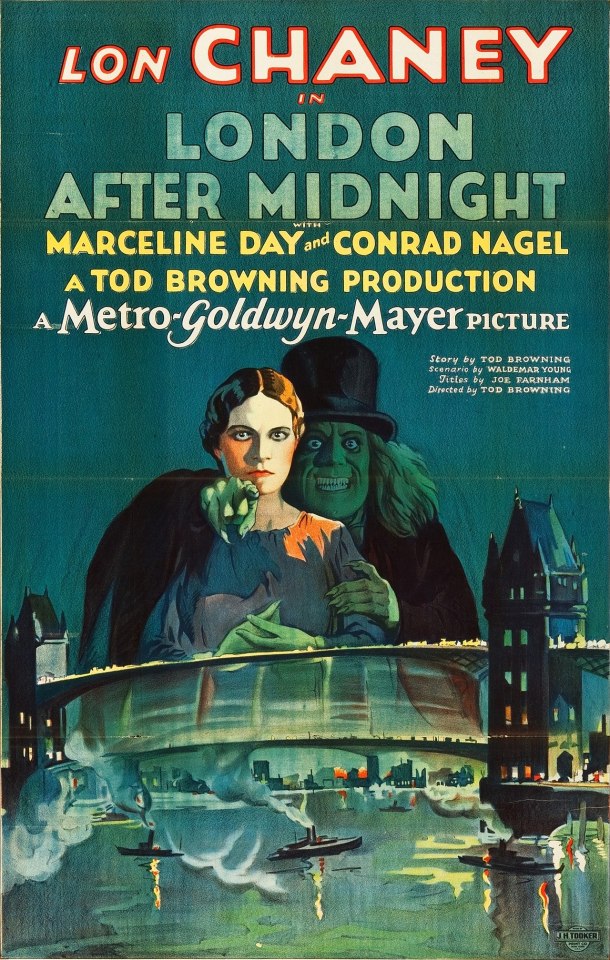
Want to watch Lon Cheyney's London After Midnight, a mystery-horror silent film from 1927? TOO BAD. The MGM vault burnt down in 1965 and the last known copy went up in smoke.
If something still exists, if it still is kept somewhere, there is always an opportunity to decide if it's worthy of being remembered. It can still be recognized for its merits, for its impact, for its importance, or just what it says about the time and culture and people who made it, and what they believed and thought and did. It can still be a useful part of history, even if we decide it's a horrible thing, a bigoted mess, a terrible piece of art. We have the opportunity to do all that.
If it's lost... We are out of options. All we can do is research it from how it affected other things. There's a lot of great books and plays and films and shows that we only know of because other contemporary sources talked about them so much. We're trying to figure out what it was and what it did, from tracing the shadow it cast on the rest of culture.
This is why archivists get anxious whenever people say "this thing is bad and should not be preserved". Because, yeah, maybe they're right. Maybe we'll look back and decide "yeah, that is worthless and we shouldn't waste the hard drive or warehouse space on it".
But if they're wrong, and we listen to them, and don't archive... We don't get a second chance at this. And archivists have been bitten too many times by talk of "we don't need copies, the original studio has the masters!" (it burnt down), or "this isn't worth preserving, it's just some damn silly fad" (the fad turned out to be the first steps of a cultural revolution), or "this media is degenerate/illegal/immoral" (it turns out those saying that were bigots and history doesn't agree with their assessment).
So we archive what we can. We can always decide later if it doesn't need preserving. And being a responsible archivist often means preserving things but not making them publicly available, or being selective in what you archive (I back up a lot of old computer hard drives. Often they have personal photos and emails and banking information! That doesn't get saved).
But it's not really a good idea to be making quality or moral judgements of what you archive. Because maybe you're right, maybe a decade or two later you'll decide this didn't need to be saved. And you'll have the freedom to make that choice. But if you didn't archive it, and decide a decade later you were wrong... It's just gone now. You failed.
Because at the end of the day I'd rather look at an archive and see it includes 10,000 things I think are worthless trash, than look at an archive of on the "best things" and know that there are some things that simply cannot be included. Maybe they were better, but can't be considered as one of the best... Because they're just gone. No one has read them, no one has been able to read them.
We have a long history of losing things. The least we can do going forward is to try and avoid losing more. And leave it up to history to decide if what we saved was worth it.
My dream is for a future where critics can look at stuff made in the present and go "all of this was shit. Useless, badly made, bigoted, horrible. Don't waste your time on it!"
Because that's infinitely better than the future where all they can do is go "we don't know of this was any good... It was probably important? We just don't know. It's gone. And it's never coming back"
10K notes
·
View notes
Text
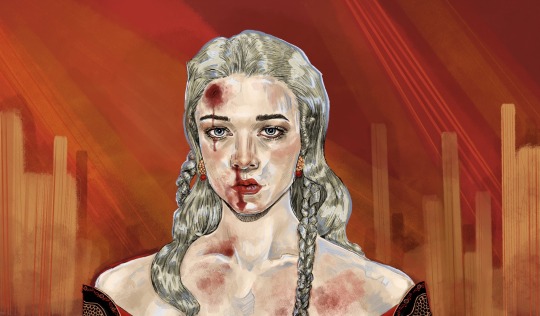


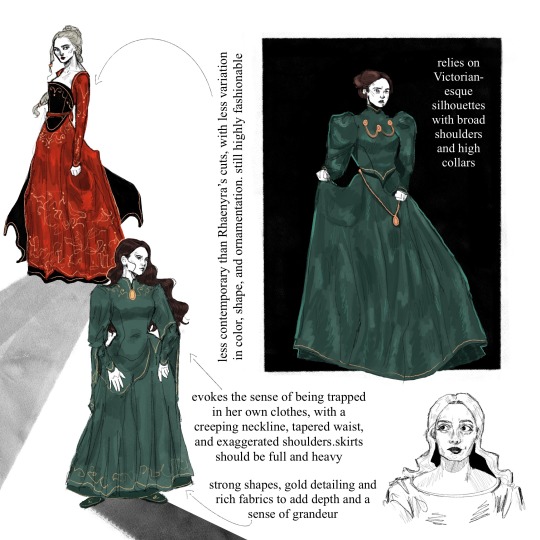

This technically applies to my Stepmother AU in which Alicent is around six years older than Rhaenyra, and occupies a wicked stepmother role as opposed to ex ‘friends-to-first loves-to-enemies’. Despite lacking the foundation of shared girlhood, both find simultaneous comfort and rivalry in one another, and undergo a gravitational pull. A young Rhaenyra’s eagerness to participate in swordplay and political affairs at a young is accommodated for, and she grows up with a sword in one hand and the weight of experience in another, which further helps pave her way to the throne.
Alicent’s Costuming
Alicent’s clothing is almost entirely bottle, emerald, or forest green. While there is layering present in her skirts and jackets, the accent should always be a darker green than the base color. The fabric is deep, rich, and retains an undeniably high-quality luster. Look to velvets and silks. Gold embroidery lingers around her sleeves, neck, and hemline to elevate the coloring.
Metallic embellishments should be almost military-like, and appear heavy. Contribute to the imagery of chains or shackles in addition to her status
Draws inspiration from historically accurate stiffness and Victorian shapes, with a tapered waist, imposing, puffy sleeves, and a high neckline. Despite inaccuracies, this shape is evocative of someone elegantly and conservatively feminine, repressed, and capable of exerting power over others. Reference a classic, trussed hourglass shape. Skirts should be notably heavy and full; may make noise in movement
The coloring and shapes remain relatively consistent but lack variation; this is to demonstrate a lack of freedom and exploration, as well as an adherence to conventional feminine roles
Despite these limitations, her costuming should always be put-together, coordinated, and unquestionably fashionable. Tight sleeve cuffs may be accompanied by a more traditionally medieval fan sleeve
Shoes should stick mostly to slippers, or flat designs
In this AU, her hair leans more towards a dark brown instead of auburn, as her show counterpart. This is mostly due to faux-book accuracy and to simplify the sketch process, since keeping her hair darker in comparison to Rhaenyra’s lighter hair translates more easily in uncolored renderings.
Keep her hair either in a tidy bun or pulled back and loose; avoid too many intricate shapes, braids, or styles. Occasionally, the hair will hang loose. Lean into medieval or royal headpieces, clips, coverings, etc.
Rhaenyra’s Costuming
Rhaenyra’s clothes are primarily black and red, occasionally accented or substituted with neutrals such as beige, white, or gray. Exceptions may include blue or yellow, but she generally stays in this color palette.
Strong focus is drawn to her shoulders and neckline, sometimes with embroidered or embellished detailing. She often has strong, angular shoulders in her dresses or jackets, occasionally theatrically pointed. Off-the shoulder necklines emphasize her collarbones and a certain broadness.
There should be decent variety in her clothing; there is a hypothetical outfit for every occasion and more (for battle, for riding, everyday, formal, feasts, everyday, etc.), and most should be composed of multiple pieces and utilize generous layering. This includes under-fabric, belts and corsets, jackets and doublets, draped fabric for aesthetic purpose, and even functional capes.
Most of her clothes should provide visual aid for movement; additional fabric to her skirts, for example. Her clothes should be highly stylized but still easy to move in. In riding and battle gear, it is presumed that she wears pants and boots under her skirts, even if they are not visible.
Shoes lean more into boot cuts, still practical but should have a sleek and uniform quality to them. When she walks, she should make some kind of noise. Shoes should usually be black or potentially red, the latter for decorative purposes.
Overall her style should be more contemporary and lean into the fantasy element. She’s not opposed to oriental details or showing skin, and her costumes should reflect both couture-height drama and period-reliant aspects. Longer lines and diagonal hems mean she is not as devoted to an hourglass shape, and her high collars should always be decorative in some respect.
Keep her hair long and mostly loose, sometimes pulled back. Small braids should be implied as incorporated. Occasional hairstyles feature complicated braids. With the exception of highly decorative braided styles, simple buns should be avoided unless accompanied with very high necklines.
Avoid headpieces that are not either a) her crown or b) ceremonial.
#rhaenicent#rhaenyra targaryen#alicent hightower#house of the dragon#hotd#rhaenyra x alicent#asoiaf#my art#thinking about how their character and costume designs are so communicative and are designed with each other in mind. for example havijg bc#the strong shoulders and embroidered necklines keeps them connected although imo they could’ve played around with it a lot more#I just have a lot of thoughts about them ok
1K notes
·
View notes
Note
how do i start to read marxist leninist/leftist stuff ? i searched on the internet but it’s super confusing lol
the most important value for me as an ML is anti-imperialism, so i guess i'll always recommend that people start with works centred on that
some suggestions below (all books should be available either on marxist.org or as pdf/epub files on libgen)
American Holocaust by David E. Stannard
about the colonization of america. not explicitly marxist, but it's probably done more to radicalize me than any other piece of writing. this is the pile of corpses capitalism is built on:
Within no more than a handful of generations following their first en counters with Europeans, the vast majority of the Western Hemisphere's native peoples had been exterminated. The pace and magnitude of their obliteration varied from place to place and from time to time, but for years now historical demographers have been uncovering, in region upon region, post-Columbian depopulation rates of between 90 and 98 percent with such regularity that an overall decline of 95 percent has become a working rule of thumb. What this means is that, on average, for every twenty natives alive at the moment of European contact-when the lands of the Americas teemed with numerous tens of millions of people-only one stood in their place when the bloodbath was over.
To put this in a contemporary context, the ratio of native survivorship in the Americas following European contact was less than half of what the human survivorship ratio would be in the United States today if every single white person and every single black person died. The destruction of the Indians of the Americas was, far and away, the most massive act of genocide in the history of the world. That is why, as one historian aptly has said, far from the heroic and romantic heraldry that customarily is used to symbolize the European settlement of the Americas, the emblem most congruent with reality would be a pyramid of skulls.
- David E. Stannard
2. Imperialism: The Highest Stage of Capitalism by Vladimir Lenin
Imperialism is capitalism at that stage of development at which the dominance of monopolies and finance capital is established; in which the export of capital has acquired pronounced importance; in which the division of the world among the international trusts has begun, in which the division of all territories of the globe among the biggest capitalist powers has been completed.
- Vladimir Lenin
3. The Wretched of The Earth by Franz Fanon
Let us look at ourselves, if we can bear to, and see what is becoming of us. First, we must face that unexpected revelation, the strip-tease of our humanism. There you can see it, quite naked, and it’s not a pretty sight. It was nothing but an ideology of lies, a perfect justification for pillage; its honeyed words, its affectation of sensibility were only alibis for our aggressions. A fine sight they are too, the believers in non-violence, saying that they are neither executioners nor victims. Very well then; if you’re not victims when the government which you’ve voted for, when the army in which your younger brothers are serving without hesitation or remorse have undertaken race murder, you are, without a shadow of doubt, executioners. And if you chose to be victims and to risk being put in prison for a day or two, you are simply choosing to pull your irons out of the fire. But you will not be able to pull them out; they’ll have to stay there till the end. Try to understand this at any rate: if violence began this very evening and if exploitation and oppression had never existed on the earth, perhaps the slogans of non-violence might end the quarrel. But if the whole regime, even your non-violent ideas, are conditioned by a thousand-year-old oppression, your passivity serves only to place you in the ranks of the oppressors.
- prefrace by Jean-Paul Sartre
4. Discourse on Colonialism by Aimé Césaire
Yes, it would be worthwhile to study clinically, in detail, the steps taken by Hitler and Hitlerism and to reveal to the very distinguished, very humanistic, very Christian bourgeois of the twentieth century that without his being aware of it, he has a Hitler inside him, that Hitler inhabits him, that Hitler is his demon, that if he rails against him, he is being inconsistent and that, at bottom, what he cannot forgive Hitler for is not crime in itself, the crime against man, it is not the humiliation of man as such, it is the crime against the white man, the humiliation of the white man, and the fact that he applied to Europe colonialist procedures which until then had been reserved exclusively for the Arabs of Algeria, the coolies of India, and the blacks of Africa
I have talked a good deal about Hitler. Because he deserves it: he makes it possible to see things on a large scale and to grasp the fact that capitalist society, at its present stage, is incapable of establishing a concept of the rights of all men, just as it has proved incapable of establishing a system of individual ethics. Whether one likes it or not, at the end of the blind alley that is Europe, I mean the Europe of Adenauer, Schuman, Bidault, and a few others, there is Hitler. At the end of capitalism, which is eager to outlive its day, there is Hitler. At the end of formal humanism and philosophicrenunciation, there is Hitler
- Aimé Césaire
5. Blackshirts and Reds: Rational Fascism and the Overthrow of Communism by Michael Parenti
probably the most accessible introduction to communism that doesn't demonize countries that have undergone—or attempted to undergo—a transitation into socalism (like the ussr, cuba, etc.)
The very concept of "revolutionary violence" is somewhat falsely cast, since most of the violence comes from those who attempt to prevent reform, not from those struggling for reform. By focusing on the violent rebellions of the downtrodden, we overlook the much greater repressive force and violence utilized by the ruling oligarchs to maintain the status quo, including armed attacks against peaceful demonstrations, mass arrests, torture, destruction of opposition organizations, suppression of dissident publications, death squad assassinations, the extermination of whole villages, and the like.
- Michael Parenti
#i'm too lazy to write an introduction for all of them#but i've included some quotes#get reading sickos#this is now on the tumblr university curriculum
7K notes
·
View notes
Note
I’m so sorry if you’ve already answered this somewhere, but how do you design your characters?
I’ve been trying to make an OC from the prohibition era and it turns out there’s basically nothing to work with for men’s outfits, so I’m curious how you made this many that look unique and fitting to the characters
There is so much to work with, though!
You will tend to find more of a focus on variety in women's fashion, but there is still quite a lot of menswear to ogle too.
I suppose it's just a matter of searching out ideas and inspiration in the rights corners. Here are a few suggestions:
Old Clothing Catalogues -
Collections from Sears-Roebuck and other popular clothing retailers are pretty easy to find compiled into relatively inexpensive books, or just floating online.
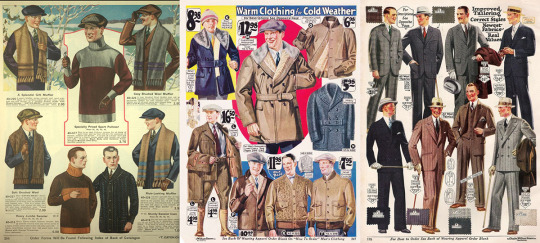
A fair bit of it is in the public domain now.
--Here's an entire 1922 catalogue of stuff to flip through.
-----------------
Contemporary Artwork -
Some phenomenal illustrators were working in this field amidst the "Golden Age of Illustration" and featured prominently on the covers of magazines and on the ads inside. There was a lot of emphasis on fashion.

Collier's and The Saturday Evening Post are a couple of the more prominent and easily searchable resources. The costuming on the cover art always has a lot of personality.
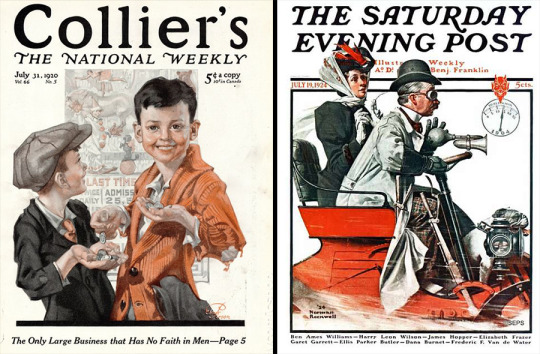
There's Rockwell, of course, and it's almost impossible to go wrong with J. C. Leyendecker. He's probably best known for his Arrow Collar ad art, but even his sock ads are like…
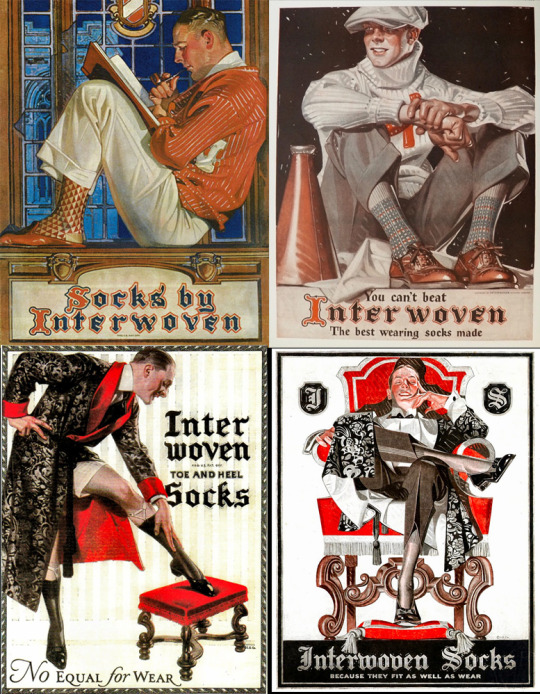
There were numerous other amazing and influential illustrators working at the time too. Here's a list of some of them.
Here's a bonus Henry Raleigh featuring some of his fabulously-dressed people.
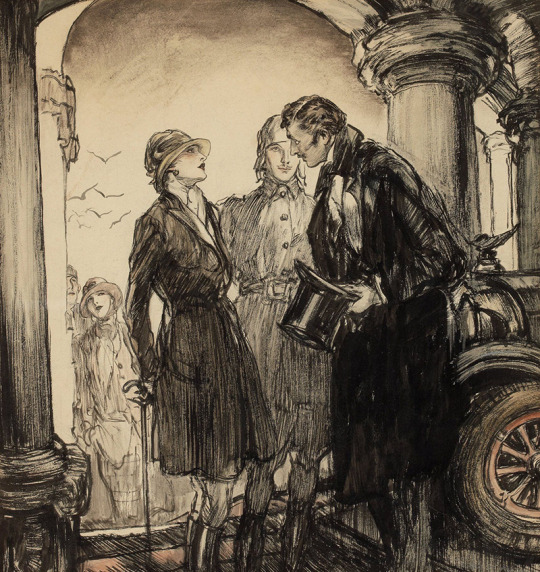
-----------------
Blogs and Articles -
There are so many of them!
If you want historical accuracy, be wary of write-ups pulling all of their references from film and television. There's nothing wrong with using those for inspiration if you aren't too concerned with historicity, but there are some pretty comprehensive and well-researched things out there with more of an eye on actual fashion history too:
--Gentleman's Gazette - What Men Really Wore in the 1920s
--The Fashionisto - 1920s Men's Fashion
-----------------
Digital Collections -
There are numerous digital historic image collections stemming from universities, museums, libraries, and the government that are free to peruse too.
--The Metropolitan Museum has a searchable catalog of exhibits that includes fashion and photos
--Here's some things from the New York Public Library
-----------------
Photos at Large -
If you aren't sure where to start, image searching for any of Hollywood's early celebrities will typically turn up a bevy of production stills and promotional photography featuring a variety of fashions.
Here's a random Getty images search for Harold Lloyd. A lot of standard 3 piece suits, but a lot of stuff with added character too.
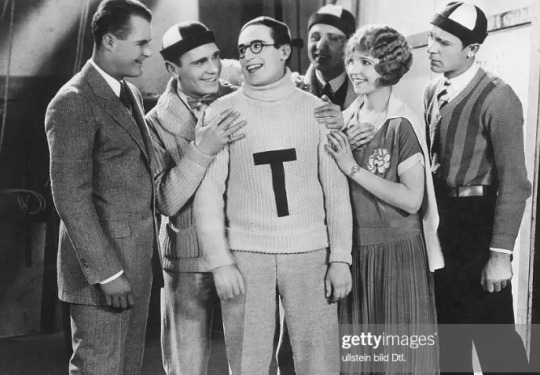
Photography was generally quite accessible by the 1920s, though, and you can find a lot of authentic photos of people from all walks of life, out in the wild wearing all sorts of clothes.
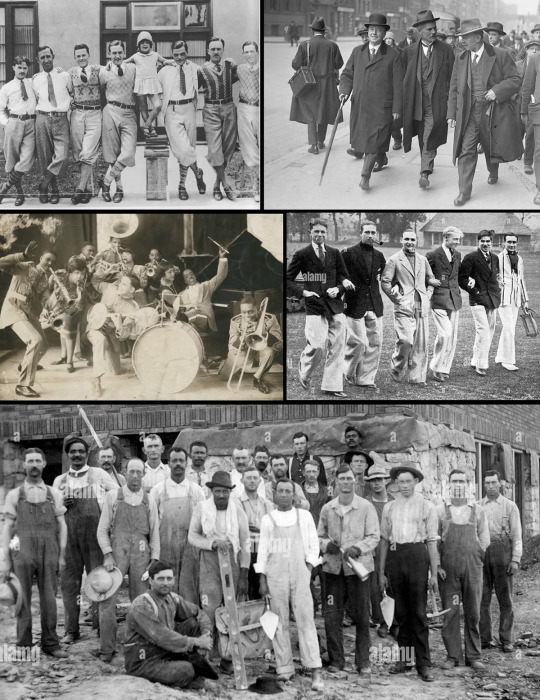
This is by no means the limit to the resources available, but hopefully it'll provide some leaping-off points for designing looks for your characters!
3K notes
·
View notes